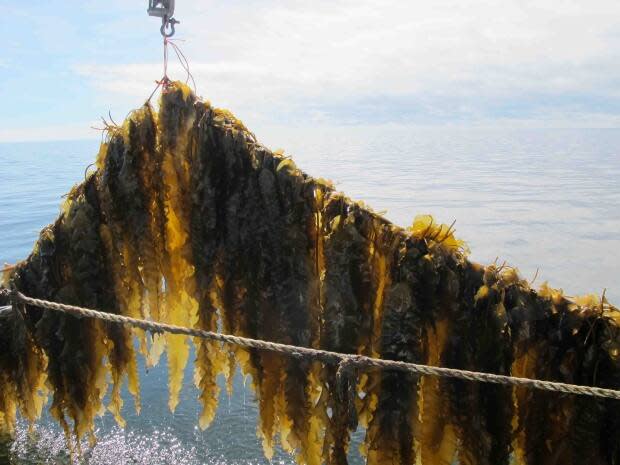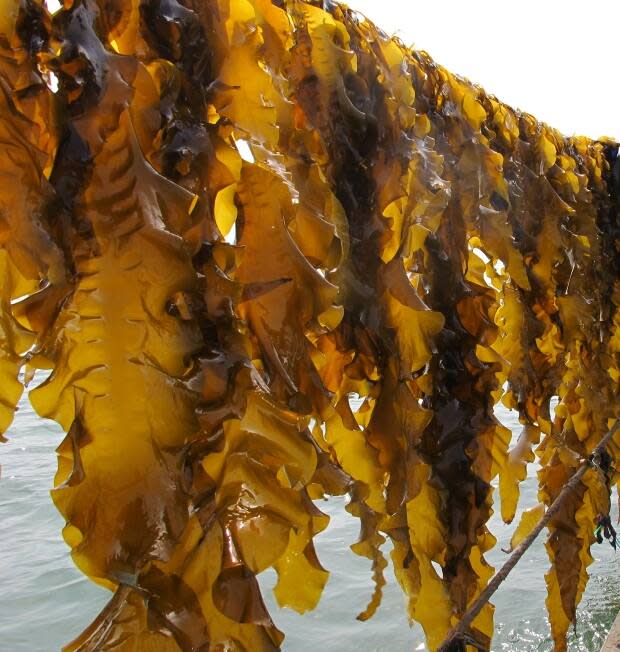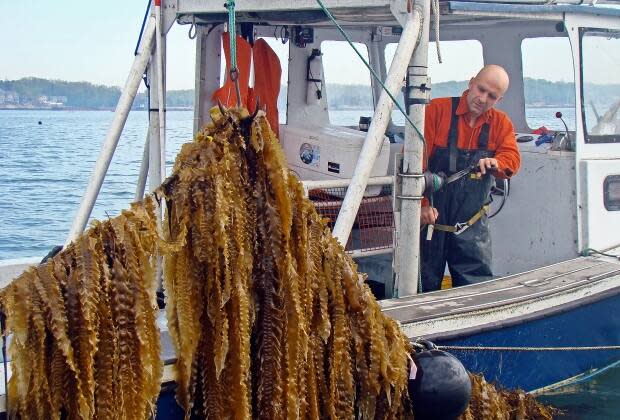Pilot project in Nova Scotia using sugar kelp could improve ocean health

A pilot project is looking at the possibility of growing kelp in Nova Scotia — part of a shift that industry representatives and researchers say could improve the health of the ocean and provide a more sustainable form of food production.
The Aquaculture Association of Nova Scotia is in the second year of a multi-year study looking into cultivating sugar kelp on shellfish leases in Cape Breton.
The practice is sometimes referred to as restorative or regenerative aquaculture.
"Cultivating shellfish and seaweed together improves the growth of both of the organisms," said Laura Carvalho Morris, the association's research and development co-ordinator. "By them working together, it's a really great water filtration system."
Sugar kelp is found throughout much of the Northern Hemisphere, including along the eastern coast of North America.

The Nova Scotia project involves collecting some of the kelp growing locally as broodstock, maturing seedlings from that stock in a lab and then spraying lines with the seedlings.
Those lines are then taken to participating shellfish leases, and wound around the ropes connecting oyster cages and mussel socks.
"And then essentially the seaweed grows from those lines over the winter and spring months," said Carvalho Morris. "And at this point, we have a one-year growth cycle recorded and we plan to, in fall 2021 ... deploy the next seeded lines and assess the growth from there."
The association has partnered with three shellfish producers in Cape Breton on the project. Tom Smith, executive director of the aquaculture association, said the first year of the project showed "extraordinary" kelp growth.
Part of that success could be attributed to the relationship between shellfish and kelp, with each species supporting the other.
"Basically, when you have an oyster that's filtering particles in the water, it promotes water clarity, and also increases light visibility to seaweed," said Carvalho Morris. "So they're able to undergo their natural processes such as photosynthesis, and ultimately grow as large as they can."
Carvalho Morris said that seaweeds, on the other hand, take up "inorganic nutrients that would otherwise be filtered into the oyster or the mussel and might, depending on what's in the water, suppress the growth of that animal."
The kelp produced from the project could be used for a variety of purposes, including human consumption. Part of the Nova Scotia project will involve looking at potential markets.
Interest in seaweed production increasing worldwide
The Nova Scotia project is part of a wave of increasing interest in aquaculture involving different levels of the food chain.
"The demand is huge," said Bren Smith, a New England kelp and shellfish farmer who started a non-profit that provides training and support to people to get into regenerative aquaculture. GreenWave currently has a waiting list of 8,000 applicants in the U.S., and about 500 in Canada, he said.
"There is this shift going on, where more and more people are looking out to the ocean as a place to rebuild and build a climate resilient economy."
Because the startup costs of seaweed production are relatively low, Smith said the industry has potential to welcome a high number of independent producers.

"We have young land-based farmers that can't afford land, former fishermen who [are finding that] fish are harder and harder to catch, folks who know nothing about the ocean but see it as a really interesting place — they want to come and learn and explore and build farms."
To provide economic and ecological stability, GreenWave encourages a "four-quadrant" business model, where farmed kelp produces human food, agricultural products such as fertilizer, data (from sensors deployed at the farm) and ecosystem services, including kelp's ability to absorb nitrogen and carbon.
Earlier this year, a study by the Nature Conservancy of Canada also suggested that this kind of aquaculture can have positive effects on local ecosystems, including through habitat creation.
Scaling up faces regulatory, economic hurdles
Thierry Chopin, a professor in marine biology at the University of New Brunswick, has worked on similar projects in the Bay of Fundy since the early 2000s.
Chopin, who coined the term 'integrated multi-trophic aquaculture' to describe the practice, said it is not only beneficial to shellfish and kelp, but can also be used to recapture and reduce waste from species such as farmed salmon.
"What is waste from one species is gold for another species," he said.
Nonetheless, Chopin said scaling up this model of seaweed production faces both commercial and regulatory hurdles.
On a regulatory level, aquaculture regulations in Canada are often aimed at one species, or group of species — such as finfish. Encouraging regulators to think about ecosystems can be a challenge, Chopin said.
"Managing one species alone, not considering the interactions with other species, we know it doesn't work. But we continue to do mono-group of species management."
Moreover, finding markets for the seaweed, which in its fresh form has to be used within days of harvest or processed shortly after harvest, is still an uphill battle in North America.
"That's a bottleneck. After being very happy that you have had a good day on the water and you have all this seaweed, what do you do with it? And at the present time that's a serious bottleneck — early processing, drying — we don't have too much capacity for that."
Chopin said the explosion of interest in multi-trophic systems of seaweed production needs to be tempered with realistic appreciation of what seaweed can do.
"I believe in seaweeds, I've been working on them for 40 years," he said. "But in the Western world, it has not been easy to scale up."
Smith, too, noted that processing infrastructure is a barrier. But on the other side of that hurdle, there is significant demand for seaweed, he said.
"You get hundreds of thousands of pounds of kelp coming out in a couple week period, and you just need to stabilize it," Smith said. "So I think this infrastructure pieces the gap that we're all trying to figure out and make work."
'It's the most natural way to do things'
Meanwhile, kelp itself is facing some challenges.
Under pressure from invasive species, warming waters and increasing storms, kelp beds have almost entirely disappeared from Nova Scotia's South Shore, although they're healthy in other parts of the province.
Carvalho-Morris said invasive species haven't been an issue in the Nova Scotia project's first year and isn't currently a focus, but "would need to be considered in the future, if other farmers look to add seaweed to their lines."
Despite these potential challenges, Carvalho Morris said the model has potential for sustainability in Nova Scotia.
"These symbiotic relationships, you know, you can't go wrong. It's the most natural way to do things, in a sense."
MORE TOP STORIES

